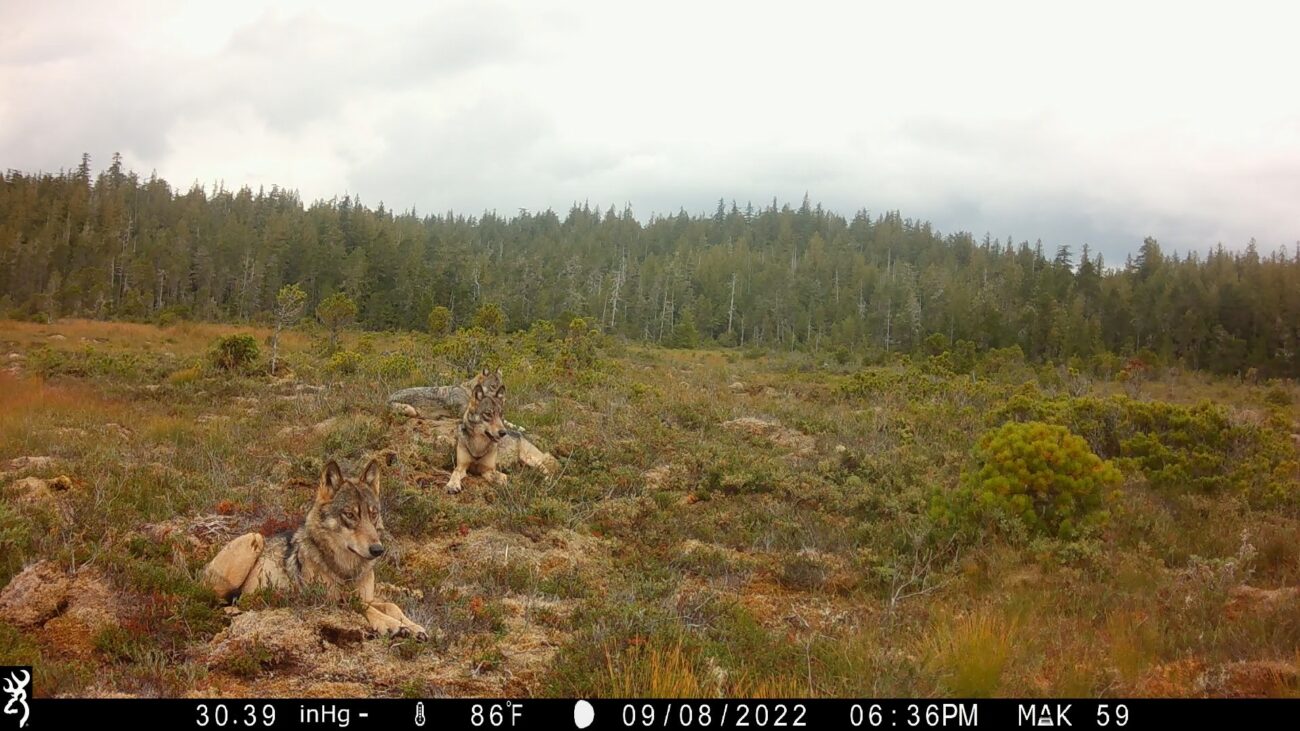
(Courtesy Mike Kampnich)
The U.S. Fish & Wildlife Service has denied a petition to put Southeast Alaska wolves on the endangered species list. It’s a blow for the environmental groups seeking the designation, but the decision vindicates widespread testimony of hunters and wildlife managers in the region.
Southeast Alaska’s wolf population could decline in the next 30 years, according to the U.S. Fish & Wildlife Service. One part of the population, located on and around Prince of Wales Island, could even die off completely – called a local extinction or extirpation.
But that doesn’t mean the wolves warrant a place on the federal endangered species list. In late August (August 22), Fish & Wildlife denied a petition to list Alexander Archipelago wolves as endangered or threatened. That population includes all of Southeast Alaska. Erin Knoll is an endangered species coordinator with the Fish & Wildlife Service in Alaska.
“Endangered is: Is the species in danger of extinction throughout all of its range, or throughout a significant portion of its range?” Knoll says. “Threatened is: Is the species in danger of extinction in the foreseeable future? So it’s not just a little less endangered, it’s: What does it look like in the future?”
“For the Alexander Archipelago wolf,” Knoll says, “The service did not find that the species meets the definition of either threatened or endangered.”
Fish & Wildlife estimates there are 2,240 Alexander Archipelago wolves alive today, most living in Southeast Alaska (1,250 wolves) with the remainder (990 wolves) in coastal British Columbia.
Knoll says Fish & Wildlife’s ruling is notable because it’s one of the first times the agency has relied heavily on Indigenous species knowledge to help inform a decision.
“Indigenous knowledge holders played a big role in the information in the species status assessment, by helping us fill some pretty big knowledge gaps,” Knoll explains – like where the wolves in the northern part of the region tend to frequent and what they like to eat.
It’s the third time the agency has declined to list Southeast wolves as endangered.
And that denial vindicates the long-standing position of state wildlife managers.
“We’ve always maintained that the wolves in Southeast are not in danger or at a risk of going extinct or of extirpation through various harvest methodologies,” says Ryan Scott, acting director for the Alaska Department of Fish & Game’s Division of Wildlife Conservation.
According to fur sealing data from ADF&G, average wolf harvest in Southeast Alaska has increased slightly in the past quarter century. But if the data excludes 2019, which Scott says was an outlier year because of new management practices in the Prince of Wales Island area, harvest in Southeast has actually decreased.
Scott also says that outside of the Prince of Wales Island area, wolf harvests are pretty low.
Wolves on and around Prince of Wales Island represent around 17 percent of the Alexander Archipelago wolves’ population – not, by Fish & Wildlife’s reckoning, the requisite “significant portion” of the range required to warrant intervention under the Endangered Species Act, even if wolves in the Prince of Wales area were to die off in large numbers.
“The other extenuating factors: forest practices, other resource uses and climate change that were noted in the petition – we just have not seen that translated to a reduction in wolf numbers,” Scott says.
Scott says the most recent petition to list Southeast wolves as endangered, filed in July of 2020, covered a much larger area than the previous two petitions (filed in 1993 and 2011, respectively). Still, he argues that Southeast wolf populations are stable.
“Based on all the data and information that we have, there was no indication of a decline in numbers across Southeast,” Scott says. “There’s often a lot of interest and attention focused on Prince of Wales Island and Prince of Wales wolves. We manage those very intensively in that we provide population estimates every year, and we’re using a scenario where we link the seasons to ensure that we don’t over-harvest the population there.”
And, Scott says, Southeast communities and resource users “overwhelmingly” condemned the petition to list Alexander Archipelago wolves as endangered.
Tim O’Connor is one community member who spoke out – he’s the mayor of Craig, a town of about 1,000 people on Prince of Wales Island. Earlier this year, O’Connor signed a petition circulated by the Klawock Fish & Game Advisory Council opposing the designation.
“It would have curtailed most or almost all logging activity in the forest,” O’Connor says, “As well as – I believe – it would have endangered the ability to subsistence deer hunt, and hunt as we do, or have for years down here.”
O’Connor says he takes issue with the assertion that Alexander Archipelago wolves are a distinct subspecies, even though the Fish & Wildlife Service designates the wolves as such.
“They say we’re an isolated population of wolves,” O’Connor says, “But they’ve managed to do just fine over here for the last 10,000 to a million years. They’ve existed with the tribes here continuously for over 10,000 years and had no issues, and they’ve existed since the white people came here and had no issues. They’re still abundant, if not over-abundant now due to the curtailed hunting and trapping. They’ve become over-abundant and they’ve impacted our deer populations considerably.”
He commends the decision by Fish & Wildlife to not list the wolves as endangered.
“I just appreciate that they used science and common sense and came to the reality that there was no real reason to list these wolves – that it was just an attempt by overzealous environmental groups to oppose hunting and logging,” O’Connor says.
He adds that he got the sense that the push to list the wolves came from outside the state.
“It’s just an attempt by somebody from another state trying to regulate Alaska,” O’Connor says, “Because they destroyed their own backyards, and now they want to mess around in ours. I do oppose that kind of opposition.”
For Alaska-based environmental advocate Cooper Freeman, though, the denied petition is a disappointment.
“We’re absolutely disappointed,” Freeman says. “Fish and Wildlife Service admits that extinction is a possible scenario for wolves on Prince of Wales Island. And these wolves are unique and irreplaceable to the fabric of the ecosystem, so we’ll keep working for their protection.”
Freeman is a representative for the Alaska chapter of the Center for Biological Diversity, a national conservation nonprofit, and one of the petitioners requesting the wolf population be considered endangered or threatened.
“We think that the Department of Fish & Game’s management objective of 150 to 200 wolves is not sustainable and that their population estimates aren’t credible,” Freeman says, “And we’re just absolutely concerned about the state’s aggressive push to increase old-growth logging on Prince of Wales. As threats from old-growth logging by the state unrestricted hunting and trapping and climate change escalate, this is one of the key tools we have to fight for the wolves.”
Freeman says his organization is still reviewing the impacts of the decision, and doesn’t know if they’ll appeal or submit another petition in the future. But the concern remains.
“While the Fish and Wildlife Service continues to fail to protect these unique and imperiled wolves, Prince of Wales Island should not be a sacrifice zone,” Freeman says, “And we’ll continue to do everything possible to keep them from sliding into extinction.”
Freeman says if the wolves were protected under the ESA, Fish & Wildlife would have to develop a recovery plan – and says the Center for Biological Diversity hopes that would include a management plan to increase their main prey source, Sitka Black-tailed deer.
Pat Lavin is an Alaska policy advisor for environmental advocacy nonprofit Defenders of Wildlife, another petitioner.
Lavin says the Defenders of Wildlife filed the petition because of concerns about the wolf population and the broader environment – at the time they filed a petition, former president Donald Trump’s administration had moved to roll back the Roadless Rule in the Tongass and expressed intent to encourage development and logging in the forest.
The Biden administration has since moved to restore roadless protections for the forest.
Lavin says it’s notable that Fish & Wildlife’s decision models out a future in which the Prince of Wales Island population experiences extirpation, or a local extinction.
“The decision certainly confirms the continued threat to at least that portion of the population of wolves in Alaska, and recognizes that deer populations fail to support human and wolf need, which is a management goal on the Tongass for the Forest Service,” Lavin says.
Lavin says whether the wolves are listed as endangered or not, he sees the challenge for the Tongass in the coming decades as one of restoring habitat and ecological function.
“On that front, we’re very supportive of the shift and management focus that has occurred in the more recent years, represented by the Southeast Alaska Sustainability Strategy (SASS), which has been really well-received in Alaska and is very popular in the region,” Lavin says. “That will require a sustained commitment and funding on a significant scale, sufficient to actually restore those healthy wildlife populations and ecological function, as well as keeping to the commitment of staying out of old growth logging, which caused that habitat destruction in the first place.”
Scott, the state wildlife conservation director, says the denied petition to list Southeast wolves won’t immediately result in change to the state’s management.
“For now, we’re going to continue the way we’re doing it,” Scott says. “We have a very intensive management system for Prince of Wales because of the attention and some of the harvests that have occurred there. Across the rest of the region, we manage specifically by harvest information and fur sealing – things like that.”
“But,” Scott adds, “We’re always changing. As we learn more, we will adapt our management to better address wolf populations. But as of now, what we’re doing is working and we’re not seeing a decline in numbers based on our current management strategies.”
Scott says engaging with Southeast hunters and other stakeholders, on all sides of the petition, has been beneficial during the federal review process.
“It’s been a long haul,” Scott says. “This is the third iteration of a petition for either Southeast Alaska wolves overall or certain segments of the population. We appreciate their patience and input. On both sides of the coin, people are engaged in the process, and it’s very pleasing to see that happening and […] being able to work with the people of Southeast Alaska is obviously beneficial to all of us.”
Although the wolves haven’t been listed as endangered or threatened now, Knoll, the endangered species coordinator with Fish & Wildlife, says petitions do bring to light the issues with declining species and can help prompt conservation and restoration efforts.
“Nobody wants a species to be listed as threatened or endangered, that’s the worst-case scenario that we’ve gotten to there,” Knoll says. “So what are things that we can do, or work with others to stop that from happening?”
Knoll says the Alexander Archipelago wolf is just one example.
“In 2020, we had a not warranted finding for Tufted puffin, and we continue to work with the seabird community to understand what’s going on there,” Knoll says. “So […] petitions bring to light the issues with species that we’re either not always aware of, or just haven’t risen to what we have time to work on.”
And, she says, the decision doesn’t bar the wolves from the endangered species list forever. Anyone could petition Fish & Wildlife to list the Alexander Archipelago wolves at any time in the future, and the process would begin again.
Get in touch with KSTK at news@kstk.org or (907) 874-2345.












